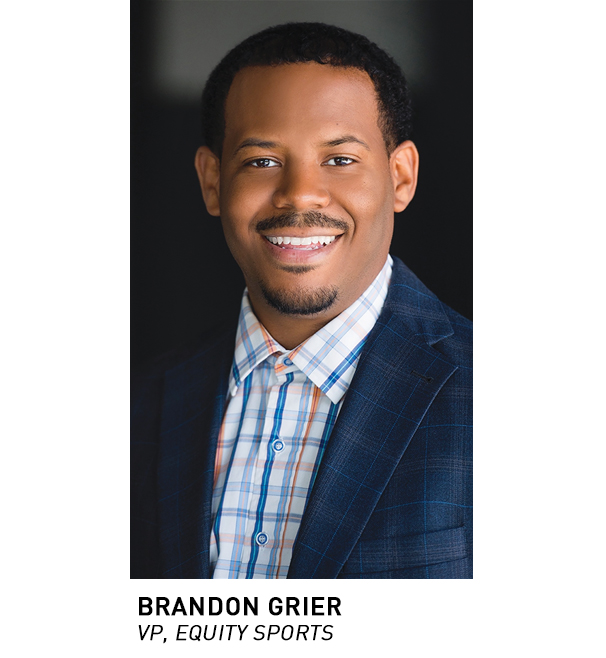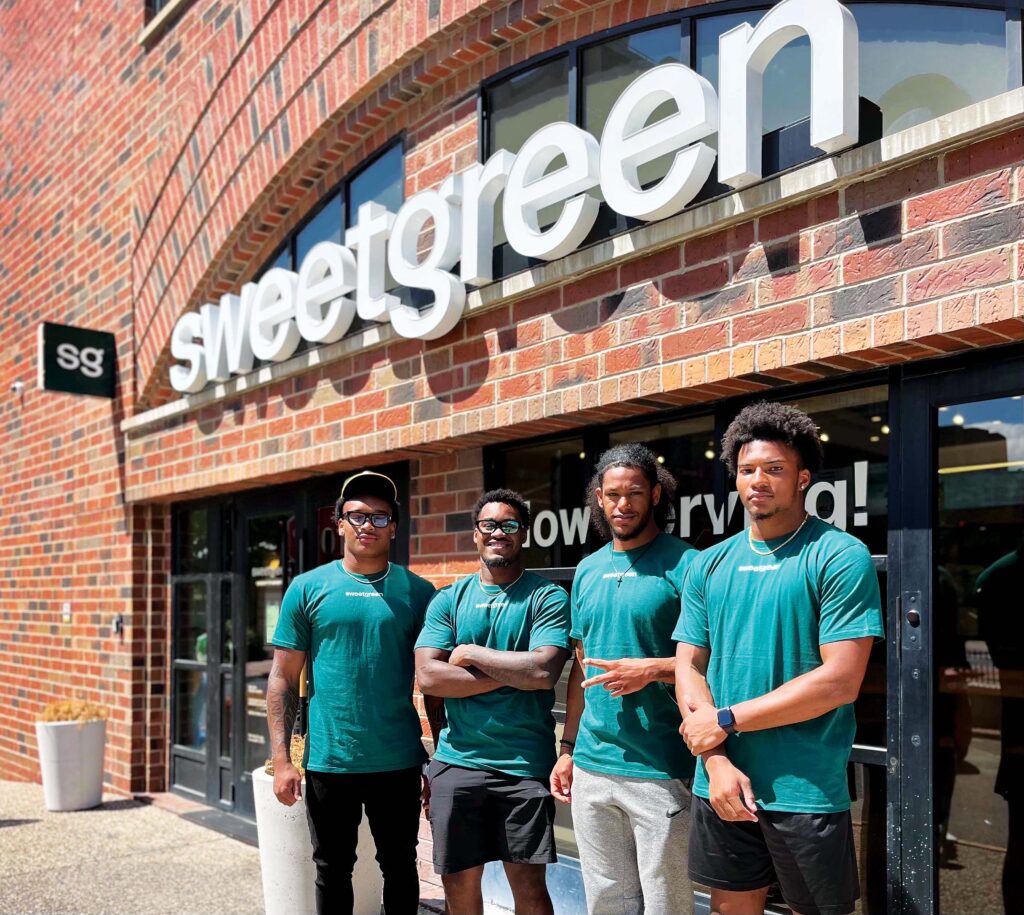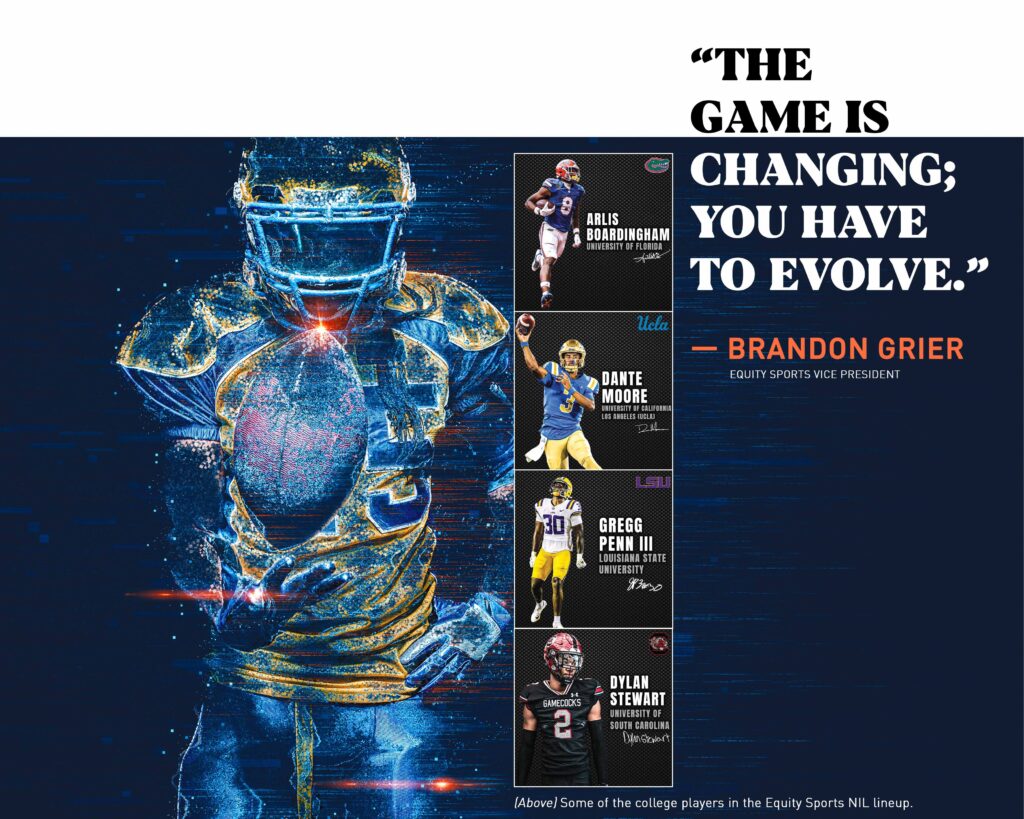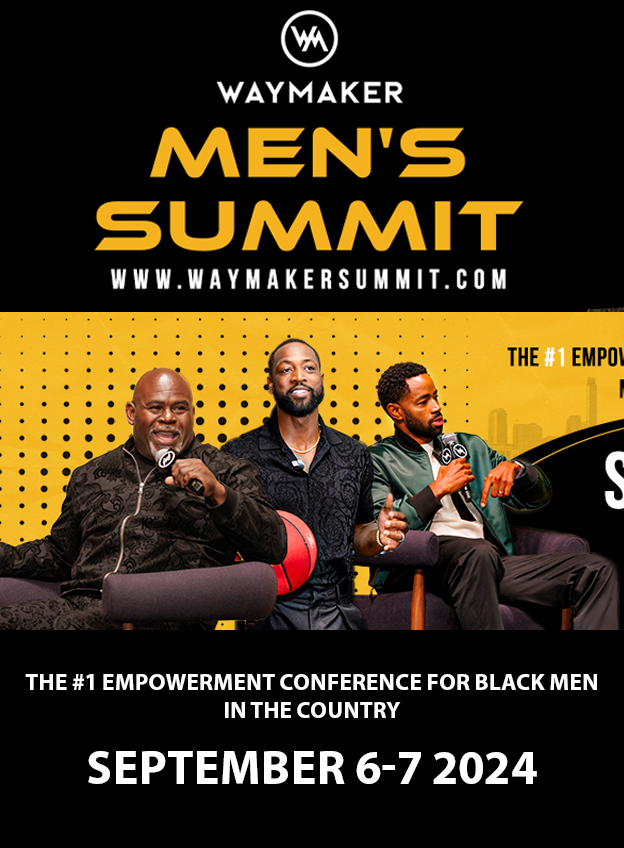For decades, college sports were big money earners—the NCAA’s annual revenues are close to $1 billion—that many thought took advantage of student-athletes’ amateur status, keeping them from benefiting from their talents. However, a 2021 Supreme Court ruling upended that longstanding bar, allowing college athletes to receive NIL compensation for their name, image and likeness.
The development has opened up new opportunities and presented some challenges. To understand the new playbook, WayMaker Journal sat down with two business leaders helping student-athletes navigate the NIL world—Athlytic founder and CEO Ashton Keys and Equity Sports vice president Brandon Grier.
A graduate of Michigan State University, Keys launched Athlytic in 2019 to help student-athletes connect with brands. One example: University of Michigan running back Blake Corum helped staff a local gourmet chocolate store for a day, generating over 100,000 social media impressions and boosting sales three times.


RELATED: Entrepreneur Justin Bayless Reveals Impact of Philanthropy and Creating Lasting Change
An NBA and NFL agent, Grier has been with Equity Sports for 12 years. The leading full-service marketing and consulting firm’s client roster includes Kansas City Chiefs quarterback and Super Bowl MVP Patrick Mahomes, the LA Angels’ Luis Garcia, James Harden of the LA Clippers and a growing number of college athletes.
WayMaker Journal: How did this NIL thing come about?
Brandon Grier: I think we’ve gotten to this point because of the NCAA’s greed; essentially, they didn’t want to have to break up their portion of the pie with the athletes. So, they said, “Here, you guys can have name and image and likeness, and that’s how you earn your money.” It’s created a new market that is finding its way as it goes . . . we’re all kind of all going off or interpreting what their blanket waiver of NIL has been in different ways. We all can agree that it should have happened, but I do believe that the NCAA kind of dropped the ball in the way that they pushed it out. And now schools, athletes and people that support [them] are all kind of interpreting what their rules are in their own way.

WJ: How was the money being made previously?
BG: In the past, schools and the NCAA both were being paid, and they’re still being paid. When they had to go before the government to talk about that, their response was to allow name, image and likeness so they did not have to tap into breaking up their pie with the athletes.
WJ: And where is most of this money coming from? TV rights? Sponsors?
Ashton Keys: TV rights, for sure: the Big Ten just signed an $8 billion media deal for TV rights. And I believe the college football playoff, which is the tournament that they just expanded, is also going to sign a billion-dollar media and TV rights deal. So, obviously, that’s a bulk up, but you still have merchandising, and you still have ticket sales. The money comes from a plethora of different things, but the biggest and the easiest thing to trace it back to is TV and media rights, [for] which these conferences are receiving multi-billions.
WJ: And how is that money split up?
AK: The Big Ten, I’m pretty sure it’s equal. I know it actually created some conflicts with the conference for the ACC . . . Florida State and Clemson are actually trying to defect from the ACC because they don’t believe that [everyone] should get an equal share of the media rights because they are obviously bearing the biggest product. The ACC is a little different because conference realignment has happened, where schools are shuffling conferences for money. SMU, who’s now in the ACC, and Cal took a shorter cut of the pie just to get in the Power conference, so they don’t receive an equal share.
BG: In basketball, when it comes to the NCAA having a media rights deal for March Madness, each conference, their share of the pie is determined by wins in the NCAA tournament. So, there’s some complexity to it, but there’s an incentive for winning.
WJ: What does the NIL arrangement mean for an individual athlete? Is it, “Hey, I’ve got a million Instagram followers, Ashton, help me out here. Can you get me paid?”
AK: That’s what it was supposed to mean and was the way they talked about it. You can use your name to promote products. You can use your image to promote products. You can use your likeness to promote product services and get paid or compensated off of that. “X brand wants to pay me to promote their product to my followers or to participate in a commercial or do an autograph signing.” That’s kind of how they explained it. [But] from that day to now, it has changed based on collectives . . . it’s transitioned to [where] probably more than 50% of NIL deals are collective-based.
BG: Their whole thing was, “We just don’t want to give up any of our money,” and because of that, it’s taken on a life of its own to where I feel like we’re headed towards college will now be another form of professional sports, because in football and basketball it’s no longer about recruiting, it’s about collectives and schools, via their collectives, creating a salary cap and going out and signing athletes to deals to try to induce them to come to their school via different avenues, which is kind of the gray area of NIL. You also see star athletes like [Caleb Williams] who won the Heisman Trophy at USC; he’s going to have commercials with Dr. Pepper, et cetera, because he’s a superstar. So, similar to professional sports, the top 10 athletes in the world are the ones with commercials, and then everybody else will get a one-off deal here or there or small deals in their market.
WJ: It sounds like schools are becoming agent-like when they’re recruiting athletes.
BG: I would say they’re more so like if you’re in the NBA or the NFL, there are salary caps in those leagues. So, these collectives are creating their own salary cap to go out and sign talent. So, they’re becoming the professional teams, not the agents per se.
WJ: When a school decides that all its equipment will be Nike, Under Armour or Adidas, do the athletes get any of that?
AK: Not at this point, no.
BG: Only the school. They’re signing that deal with the school. And when you sign your scholarship or you agree to play there, unless you have a NIL deal with the individual sports apparel company, you have to wear that.
RELATED: The Real Deal
WJ: What happens if, say, you sign with a school that has a deal with Nike, but you have your own NIL deal with Adidas?
AK: You can’t wear those shoes. There are a couple of players like that in women’s basketball, both at Louisiana State University. Flau’jae Johnson has a deal with Puma, but on the court, she’s wearing Nike. So is Hailey Van Lith, who has a deal with Adidas. There’s no exceptions. I think the only person that ever was able to get a waiver for that, and this is pre-NIL, was the young Marcus Jordan . . . I think everyone understood it would be weird if your dad is Michael Jordan and you wear Adidas on the court.
WJ: So, has the NIL ruling made things better, and if so, for whom?
AK: That depends on who you’re talking about. For schools, roster management is strict, and especially depending on where you are. If you’re not Power Five, it’s hard to keep your top players now because they can get more money elsewhere.
BG: As a player advocate, I think it’s amazing. America is a capitalistic place, and I think it’s exposed some of these red states or people who say they have certain views, but now that it comes time for these athletes that they’ve had pretty much giving free labor for all these years to get paid, they see it as problematic. The game is changing; you have to evolve and it’s a new way of doing things.
WJ: How has the agent business been affected?
BG: It’s a whole new category for us. You can sign [someone] at a much younger age, and you take the chance of, it could be a big benefit for you to sign a guy at 18 as he’s entering college, and now you can help build his brand and his business acumen from college through his transition to the pros. But also, there’s a risk that you may sign someone, not service them at a high level and now you’ve eliminated yourself from being in the pool to represent them as pros. It’s pros and cons, depending on how you approach it and how you handle it.

WJ: Are these young athletes aware or educated enough to handle it all?
AK: I don’t want to say no, but I want to say that there are resources that are needed to support [them] and having the right team, having a good agent, helps for sure. But sometimes, having a team can be a crutch as well. We did a survey and [found that] about 60% of our athletes don’t read their contracts and that’s very scary because you have to understand the implications of what you’re signing. Sometimes they look at it and they say, “My team, they looked at it, it’s good.” But we know, like everyone knows, that so many people have been taken advantage of by their team, whether it’s a financial adviser, whether it’s an agent . . . so [there is a balance between] having the resources for them to learn and actually put the right effort in themselves to read and understand what they’re looking at and still getting and taking advice from their team versus letting their team handle everything. When you have so many people that come from certain backgrounds who’ve never had this type of money, who’ve never had these experiences, it can create a crisis. And they’re still kids. You don’t know how many kids that I’ve had to chase down to make sure they show up for this [event], make sure they post at this time. They don’t understand the magnitude of some of the things that they’re receiving at that age, and the maturity level is lower, so it becomes difficult sometimes. It’s a lot of pressure, and I’ve had athletes say that it affects their mental health because you’ve had athletes where because they had a NIL deal it was used against them: “We paid them how much? Why are they not winning games?” It’s a lot to take in.
60% of our athletes don’t read their contracts, and that’s very scary
Ashton Keys
BG: I think it’s about exposure and education. I’ve seen some of the same characteristics that make my clients elite athletes serve [them] in being good businesspeople . . . the discipline that they have, when they’ve been exposed and taught the right way to do good business, they’re able to apply that to this area of their life. The real trap that I’ve seen is when they’re not educated, and their team doesn’t prepare them for things like taxes, and now they’ve got all of this money as a company (because a lot of the deals go through their LLCs). Then, at the end of the year, they either aren’t educated on the fact that they have to pay taxes, and now that money may have been spent, and now they’re in trouble.
WJ: Are there any programs in place to help student-athletes with financial strategies like deferments, like corporations do?
BG: Right now, the NCAA and the member institutions, the universities, they’re hands-off to this. All of the business dealings and money are happening outside of them, and that’s by design . . . I think eventually, we’ll get to [where] the universities will be paying a salary to the players. But right now, that’s not where we’re at . . . all of this is happening outside of the universities and the NCAA directly.
WJ: That sounds like a great opportunity for someone to provide that kind of service!
AK: It’s needed. There’s a lot of money getting thrown around.
BG: It’s like any new industry; there’s a ton of opportunities.
WJ: How well do you think this is all working right now?
AK: Like we talked about earlier, we can’t have this hands-off method or model. We have to start bringing things in-house under the university. This whole notion of, “Oh, it’s a separate entity, but it’s somehow connected to the university, but not connected to the university,” makes it confusing for everybody. I think we need to create some type of similarity to the pro level. If we are going to do revenue share from the media rights deals, having some sort of salary cap or way we balance out how the money is distributed across the sports [would be good]. But outside of that, in looking at it holistically, the way the deal side works [is good].
BG: I’m very happy with how things are working right now because it’s very player-friendly. To me, things were one extreme for so long, and now the system has been disrupted, and a lot of colleges and universities that had their way because they had a great recruiter and he could just go and talk about the nonmonetary benefits . . . well, NIL has evened the playing field to where everybody has a chance. And for me, I don’t see any issue with that. It’s great for the elite athletes to [go] where the market determines their value.


